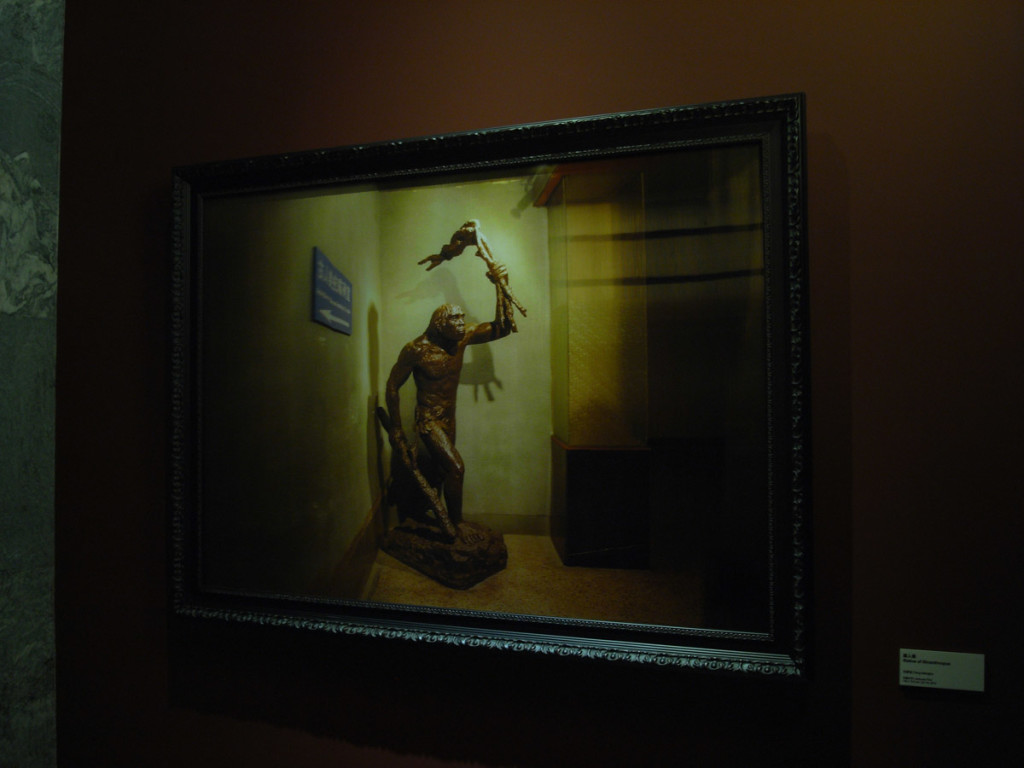Feng Mengbo 冯梦波: My Private Museum 私人博物馆
Shanghai Gallery of Art, 3F,3 Zhongshan Dong Yi Road,Shanghai
September 4 -October 25, 2012
Feng Mengbo went on a tour to the Shanghai Natural History Museum, and took some photos of its display. Now we can see the photos which Feng took on display at the Shanghai Gallery of Art, a few blocks further. (Feng was not the only one these guys went there too, even before him, but they were not artists).
The photographs show the dilapidated state of the often outdated natural science displays. The displays at the Museum have been worn out in a number of ways: The materials they were made of have decayed. The museum display techniques have changed since then. The knowledge about some of the scientific fats has advanced or changed. The ideology infused in the displays has changed… wait… has it?
One of the claims made in the accompanying texts is that in the photographed displays “the development of species is not only a biological occurrence—but is subtly linked to the Communist idea of the inevitable fruition of the socialist revolution.” (here) — True, however what is presented here as a relic of the past, is still much alive in China. China has indeed moved on from its “revolutionary years, period of socialist construction period and era of opening-up and reform.” (here) The ideological vocabulary has been updated since then. The Museum display lags behind a bit. But the ideology in the Museum’s display has not been discarded, it has been updated. And that is a subtle but important difference.
Feng’s photographs on display are not presented as a document, for a number of reasons: They are mounted in a highly theatrical way, the accompanying text presents them as original artwork and not a document, different media (black and white, color, 3D) are chosen for display without any apparent reason, etc. Most importantly, there is no clear aim as to what has to be documented and why. Rather than documentary, the phonographs and their installation dwell on and emphasize the ‘freak show’ effect of a cabinet of curiosities.
As original artwork, the photo exhibition is quite a big change compared to Feng’s computer-game related work. The curator explains the continuity by pointing out that “Feng has always been interested in great historical narratives”, which are supposedly present both in his Long March videogame as well as in hisPrivateMuseum. However I see these two works as completely opposite. The Long March computer game is basically reproducing an existing ideological narrative, transforming it into a new medium and strengthening it without much critical reflection. However thePrivateMuseumdoes not appropriate and reproduce an existing ideologically charged story. It reproduces bits and pieces of possible historical artifacts. The content and story of the photographs should to be interpreted by the viewer himself, but the interpretative space for thinking is narrowed down by the ‘artistic’ treatment of the subject by Feng.
The result is ambivalent: A quasi-documentary approach, where, however, the object of observation is obscured through artistic means. The artist puts the present in front of the viewer, pretending it is the past, however refrains from any statement or intervention in the material that would clarify his objective, and – on the contrary – uses his artistic skills for simply reproducing and decorating the ideological apparatus inherent in the depicted subject – that of “enlightening” through misleading.
What is on display is an unprocessed reproduction of facts, which is not contested or critically analyzed. We can conclude that even though the medium has changed from computer games to photography, the work is indeed aligned with Feng’s previous work: Aligned in offering an oversaturated reproduction of what we have already seen or known, while limiting the possibilities of questioning what we actually see.
